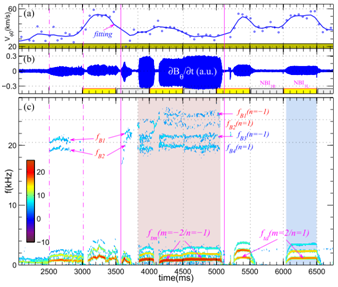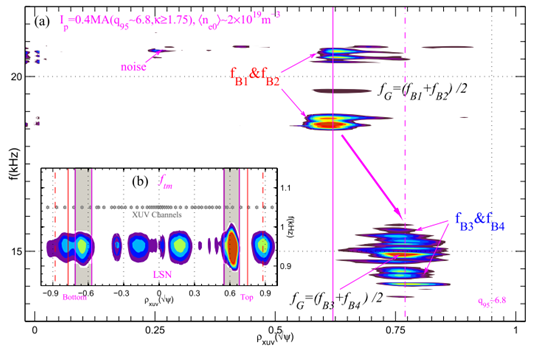
count: [2018-11-29] [Close]
In fusion devices, hundreds-of-million-degree plasma inevitably suffers from collective instabilities, which can easily reduce the heating efficiency of fast ions or even the production of nuclear fusion. Alfven Eigenmodes is one kind of the instabilities with non-axis-symmetries.
Understanding the internal excitation mechanism for Alfven Eigenmodes instabilities is a key to find solutions to better control plasma instabilities and achieve a higher performance.
Recently, after an experimental analysis on the lower frequency Alfven Eigenmodes, scientists of EAST team found that this type of instabilities closely correlated with the injection of impurities.
In the past, the conventional pair of Beta-induced Alfven Eigenmodes (BAEs), a branch of Alfven Eigenmodes, was observed and characterized by counter-propagating waves, which has the same helicity as the magnetic island during strong tearing mode activities.
On EAST, scientists observed a lower-frequency pair of BAEs, which has the similar characteristics as the conventional BAEs. These two pairs of BAEs are actually discrete modes in the radius direction that located at different positions. For the first time, the spatial structures of the two pairs of BAEs is demonstrated
Based on the experiment observation, Scientists explored the possible burst conditions for these BAEs. They discovered that the excitation of the discrete double pairs of BAEs have strong relation with 2/1 snake perturbations, which are easily excited by the high-Z impurities (e.g. tungsten). The detailed spatial structures of such fluctuations demonstrate a strong non-axis-symmetries along poloidal direction, which shows that the free energy produced by the snake fluctuations plays an important role in the excitation.
This study furthers the understanding of the internal mechanism of plasma instabilities, may lead to the development of a reliable controlling method to achieve long pulse steady state operation on EAST and on the future International Thermonuclear Experimental Reactor (ITER). (XU Ming reports)
Article link: http://iopscience.iop.org/article/10.1088/1741-4326/aae8b7/meta


